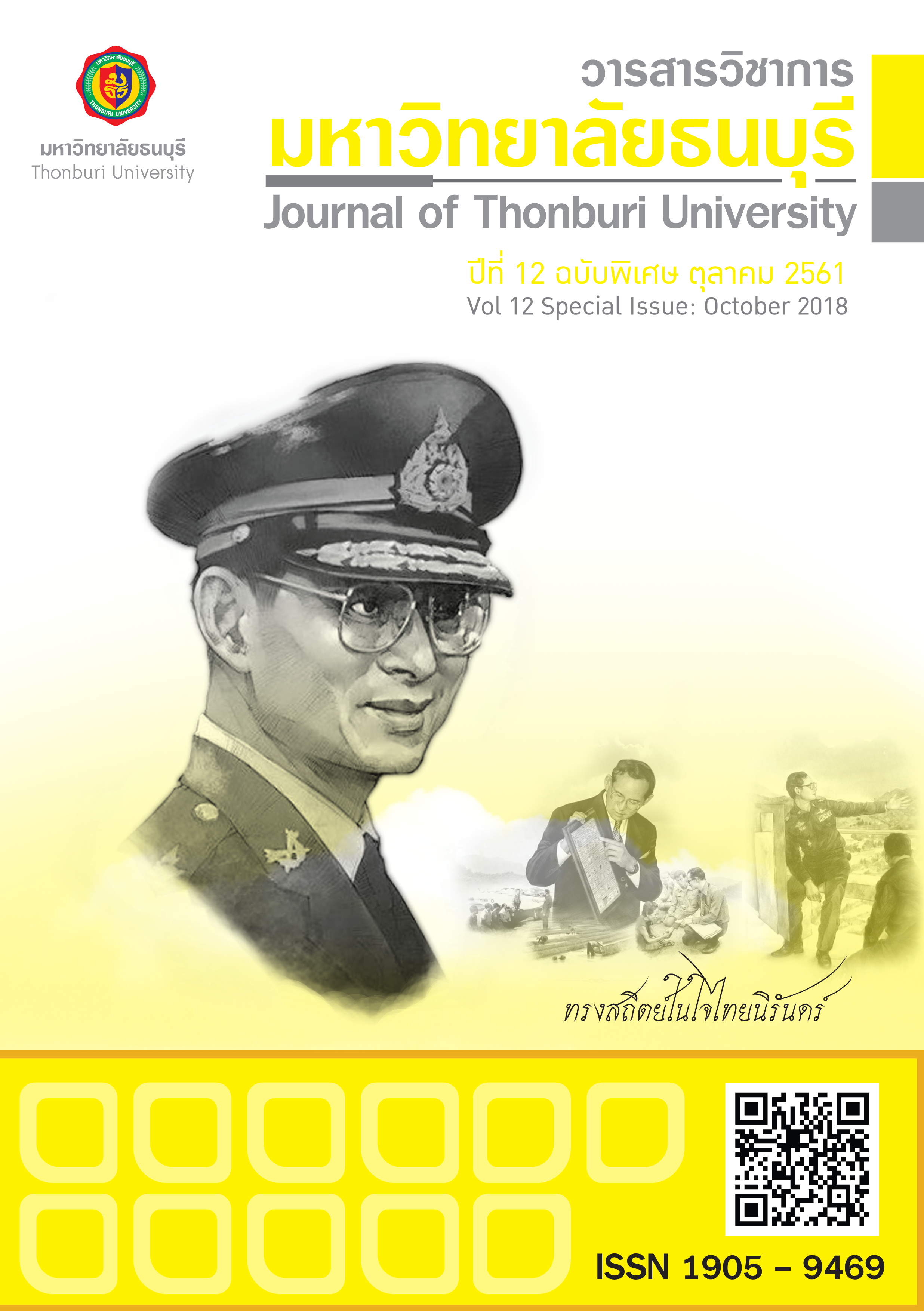A DEVELOPMENT OF FLIPPED CLASSROOM INSTRUCTION MODEL TO ENHANCE LEARNING ACHIEVEMENT IN THE PRINCIPLES OF TEACHING PROFESSION COURSE
Main Article Content
Abstract
Abstract
The objectives of this research were: 1) to develop a flipped classroom instruction model to enhance learning achievement in the principles of teaching profession course; and 2) to tryout and examine the effectiveness of the model. The sample consists of 28 second-year students of the Faculty of Technical Education, Production and Industrial Engineering Program, King Mongkut’s Institute of Technology North Bangkok. The research instruments comprise an appropriate evaluation form, a learning achievement test with Index of Item-Objective Congruence (IOC) of 0.8-1.0, Item Difficulty Index of 0.20-0.80, Item Discrimination higher up than 0.29, with reliability of 0.89; the satisfaction scale with IOC of 0.8-1.0, with reliability of 0.98. The statistics used for data analysis involved mean, standard deviation, t-test one sample group.
The results were found as follows: 1. The flipped classroom instruction model to enhance learning achievement in the principles of teaching profession course contains 3 stages: 1) lessons analysis; 2) Instruction management strategies including (2.1) Studying lessons at home, doing homeworks at school; (2.2) peer teaching learning and sharing; (2.3) Brain storming; (2.4) Applying knowledge in class; and 3) Evaluation with the experts’ opinions about the flipped classroom instruction model at the high level of appropriateness. 2. The effectiveness of the flipped classroom instruction model indicated that the learning achievement in the principles of teaching profession course of students was higher than the set criteria at the statistically significant level of 0.05 and the students’ overall satisfaction on the flipped classroom instruction model was at the highest level.
Keywords: Flipped classroom instruction model, Principles of Teaching profession, Learning achievement
Article Details
References
กวินธร รัฐอาจ; เหมมิญช์ ธนปัทม์มีมณี; และ ฉัตรเกล้า เจริญผล. (2559). การพัฒนารูปแบบการเรียนการสอนแบบห้องเรียนกลับด้านด้วยคลังรายวิชาออนไลน์แบบเปิด. วารสารศึกษาศาสตร์ มหาวิทยาลัยมหาสารคาม. 10(พิเศษ): 68-82.
กาญจนา เงารังษี. (2559). การศึกษากับการพัฒนาที่ยั่งยืน. วารสารสมาคมนักวิจัย. 21(2): 13-18
กิตติพันธ์ อุดมเศรษฐ์, ปราวีณยา สุวรรณณัฐโชติ; และ อรจรีย์ ณ ตะกั่วทุ่ง. (2560). การพัฒนารูปแบบการออกแบบการเรียนการสอนแบบการเรียนรู้กลับด้านตามกรอบแนวคิดทีแพคและทฤษฎีขยายความคิดสาหรับครูมัธยมศึกษาสังกัดสำนักงานคณะกรรมการส่งเสริมการศึกษาเอกชน. วารสารศึกษาศาสตร์ มหาวิทยาลัยนเรศวร. 19(14) : 24-38
ชลยา เมาะราศี. (2556). ผลการเรียนที่ใช้วิธีการสอนแบบย้อนกลับร่วมกับห้องเรียนกลับด้านบนเครือข่ายสังคม ในรายวิชาการวิเคราะห์และแก้ปัญหา สำหรับนักเรียนชั้นมัธยมศึกษาปีที่ 5. วิทยานิพนธ์ศึกษาศาสตรมหาบัณฑิต มหาวิทยาลัยพระจอมเกล้าธนบุรี.
ธนภรณ์ กาญจนพันธ์. (2559). ผลการจัดการเรียนรู้แบบห้องเรียนกลับทางที่มีต่อผลสัมฤทธิ์ทางการเรียนวิชาชีววิทยาการกำกับตนเอง และความพึงพอใจต่อการจัดการเรียนรู้ของนักเรียนชั้นมัธยมศึกษาปีที่ 5. ศึกษาศาสตร์มหาบัณฑิต. มหาวิทยาลัยสงขลานครินทร์.
นิอิบณูรอวี บือราเฮง. (2558). ผลของการสอนแบบบูรณาการด้วยการสอนแบบห้องเรียนกลับด้าน สื่อประสม และนวัตกรรมคุณลักษณ์ศึกษาด้านทักษะทางสังคมที่มีต่อพฤติกรรมและผลสัมฤทธิ์ทางการเรียนสาระการเรียนรู้ศาสนประวัติของนักเรียนชั้นมัธยมศึกษาปีที่ 1. ศึกษาศาสตรมหาบัณฑิต มหาวิทยาลัยสงขลานครินทร์.
ปิยะวดี พงษ์สวัสดิ์; และ ณมน จีรังสุวรรณ. (2558). การออกแบบรูปแบบการเรียนการสอนแบบห้องเรียนกลับด้านโดยใช้กิจกรรม WebQuit เพื่อพัฒนาทักษะการเรียนรู้ในศตวรรษที่21สำหรับนักศึกษาในระดับอุดมศึกษา. วารสารวิชาการครุศาสตร์อุตสาหกรรม พระจอมเกล้าพระนครเหนือ. 6(1): 151-157.
พนมนคร มีราคา.(2560). ครูต้องมีลักษณะอย่างไร... ในศตวรรษที่ 21. วารสาร “ศึกษาศาสตร์ มมร”. 5(2): 23-35
พิมพ์ประภา พาลพ่าย. (2557). การใช้สื่อสังคมตามแนวคิดห้องเรียนกลับด้าน เรื่อง ภาษาเพื่อการสื่อสาร เพื่อส่งเสริมผลสัมฤทธิ์ทางการเรียนของนักเรียนชั้นประถมศึกษาปีที่ 6. ศึกษาศาสตรมหาบัณฑิต มหาวิทยาลัยเกษตรศาสตร์.
เมธาวรินทร์ สัจจะบริบูรณ์; และ ศัลยพงศ์ วิชัยดิษฐ (2558). การศึกษารูปแบบการเรียนรู้ภควันตภาพสาหรับห้องเรียนกลับด้าน: กรณีศึกษามหาวิทยาลัยราชภัฏนครปฐม. การประชุมวิชาการระดับชาติ มหาวิทยาลัยราชภัฏนครปฐม ครั้งที่ 7. 7(1): 1-7.
วริศนันท์ เดชปานประสงค์; และคนอื่นๆ (2558). การพัฒนารูปแบบการเรียนการสอนวิชาวิทยาศาสตร์ที่ส่งเสริมจิต 5 ลักษณะเพื่ออนาคต สำหรับนักเรียนชั้นมัธยมศึกษาปีที่ 1. วารสารวิชาการมหาวิทยาลัยธนบุรี. 9(19): 40-50.
วิจารณ์ พานิช. (2556). ครูเพื่อศิษย์สร้างห้องเรียนกลับทาง. กรุงเทพฯ: เอส.อาร์.พริ้นติ้ง
สุพรทิพย์ ธนภัทรโชติวัต; และคนอื่นๆ (2558). การพัฒนารูปแบบการจัดประสบการณ์วิชาชีพครูเพื่อส่งเสริมคุณลักษณะครูในศตวรรษที่ 21. วารสารศึกษาศาสตร์มหาวิทยาลัยนเรศวร. 17(1): 33-48.
สุพัตรา อุตมัง. (2558). แนวคิดห้องเรียนกลับด้าน : ภาพฝันที่เป็นจริงในวิชาภาษาไทย. วารสารวิชาการศึกษาศาสตร์ คณะศึกษาศาสตร์ มหาวิทยาลัยศรีนครินทรวิโรฒ. 16(1): 51-58
สุรศักดิ์ ปาเฮ. (2559). ห้องเรียนกลับทาง:ห้องเรียนมิติใหม่ในศตวรรษที่ 21. สืบค้นเมื่อ 2 กุมภาพันธ์ 2559, http://www. mbuisc.ac.th/phd/academic/flipped%20classroom2.pdf
อาลาวีย๊ะ สะอะ. (2557). ผลการจัดการเรียนรู้แบบห้องเรียนกลับทางที่มีต่อผลสัมฤทธิ์ทางการเรียน ทักษะการคิดวิเคราะห์และความพึงพอใจต่อการจัดการเรียนรู้ของนักเรียนชั้นมัธยมศึกษาปีที่ 5. ศึกษาศาสตร์มหาบัณฑิต, มหาวิทยาลัยสงขลานครินทร์.
Translated Thai References
Bueraheng, N. (2015). Effects of Integrated Teaching by Using Flipped Classroom, Multimedia, and Innovation in Character Education in Social Skills on Behavior and Academic Achievement in Religious History Subject of Grade Seven Students. (Master of Education, Prince of Songkla University). (in Thai).
Cherngsri, Kanchana. (2016). Education for Sustainable Development (ESD). Journal of the Association of Researchers. 21(2): 13-18. (in Thai).
Dechpanprasong, W.; and other. (2015). The Development of A Science Instruction Model-Enhancing Five Minds for The Future for Mathyom Suksa 1. Journal of Thonburi University. 9(19): 40-50. (in Thai).
Kanjanapan, T. (2016). Effect of Flipped Classroom Approach on Biology Achievement, Self-Regulation and Instructional Satisfaction of the Grade 11 Students. (Master of Education Thesis, Prince of Songkla University). (in Thai)
Meeraka, Phanomnakhon. (2017). How do teachers look in the 21st century?. MBU Education Journal: Faculty of Education Mahamakut Buddhist University, 5(2): 23-35. (in Thai)
Ministry of Education. Office of The Permanent Secretary. (2017). Education Development Plan, Ministry of Education No. 12 (2017-2021). Retrieved April 20, 2017, from https://www.dropbox.com/s/oyoof2
(in Thai).
Morrasi, C. (2013). Learning achievements from the backward design instruction and flipped classroom on social Network for the course in problem analysis and solution for grade 5 students. (Master of Science in Industrial Education, Industrial Education and Technology, King Mongkut's University of Technology Thonburi). (in Thai).
Outamung, Supatta. (2015). Flipped Classroom: a Dream Come True in Teaching Thai Language. Journal of Education Srinakharinwirot University. 16(1): 51-58. (in Thai).
Pae, Surasak. (2016). The Flipped Classroom : New Classrooms Dimension in the 21st Century. Retrieved February 2, 2016, from http://www.mbuisc.ac.th/phd/academic/flipped%20classroom2.pdf (in Thai).
Panich, Vicharn. (2013). Teacher for Disciples Flapped Classroom. Bangkok: S.R. Pinting. (in Thai).
Phanphai, P. (2014). The Social Media Utilization with the Flipped Classroom Theory on Language for Communication to Enhance Learning Achievement of Prathomsuksa 6 Students. (Master of Education, Kasetsart University). (in Thai).
Pongsawat, Piyawadee. and Jeerungsuwan, Namon. (2015). The Instruction Design Flipped Classroom Model by Using WebQuest Activities to Develop Learning Skills in The 21 st Century for Students in Higher Education. Journal of Industrial Education, King Mongkut's University of Technology North Bangkok. 21(2): 151-157. (in Thai).
Rattaoaj, K., Thanapatmeemanee, H.;& Jareanpon, C. (2016). The development of Flipped classroom instruction with Massive open online courses. Journal of Education, Mahasarakham University, 10(Special Edition): 68-82
(in Thai)
Saa, Arlawiya. (2016). Effect of Flipped Classroom on Learning Achievement, Analytical Thinking Skills and Instructional Satisfaction of Grade 11 Students. (Master of Education Thesis, Prince of Songkla University).
(in Thai)
Sajaporibun, Methavarin.;& WichaibitS, ueyapong.(2015). The Study of a U-Learning Model for Flipped Classroom: Nakhon Pathom Rajabhat University. The 7th NPRU Academic Conference 2015, 7(1): 1-7. (in Thai)
Thanaphatchottiwat, S.; and other. (2015). The Development of Teaching Professional Experience Model for Enhancing the Required Characteristics of Teacher in the 21st Century. Journal of Education Naresuan University. 17(1): 33-48.
(in Thai)
Udomseth, K.; Suwannatthachote, P.; & Na Takuatoong, O. (2017). Development of a Flipped Learning Instructional Design Model Based on TPACK Framework and Elaboration Theory for Secondary School Teachers under Office of the Private Education Commission. Journal of Education Naresuan University. 19(14): 24-38. (in Thai)

